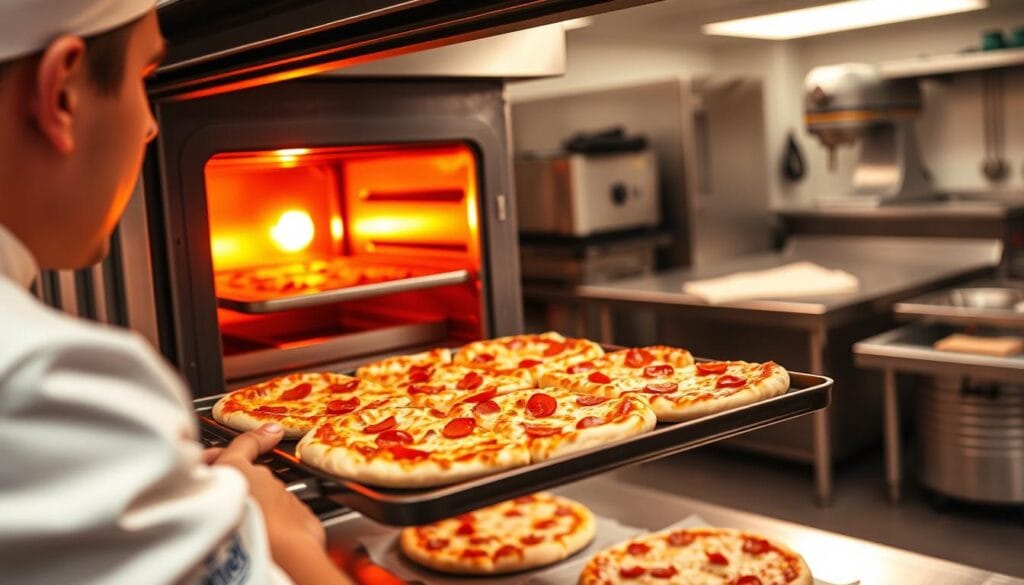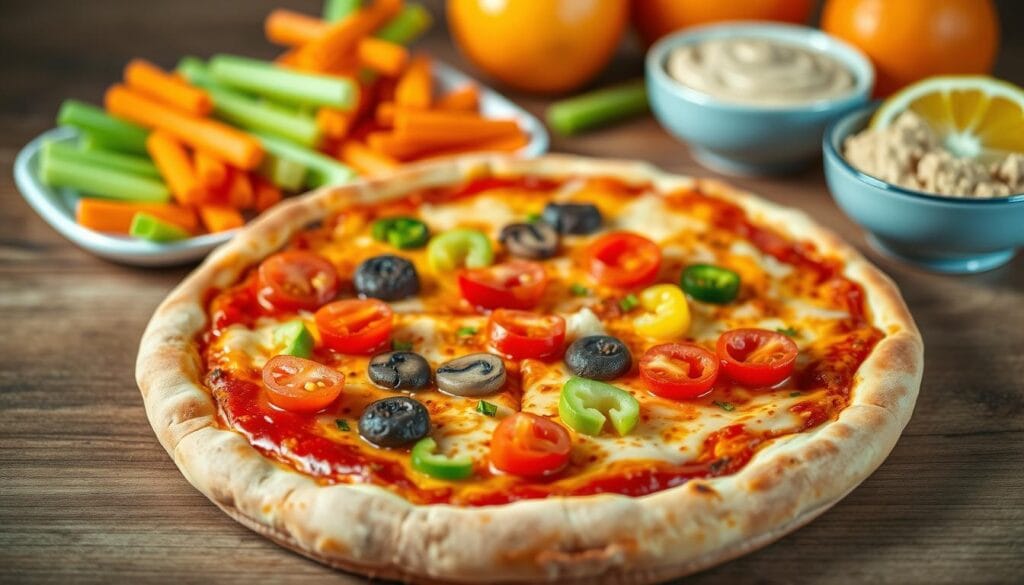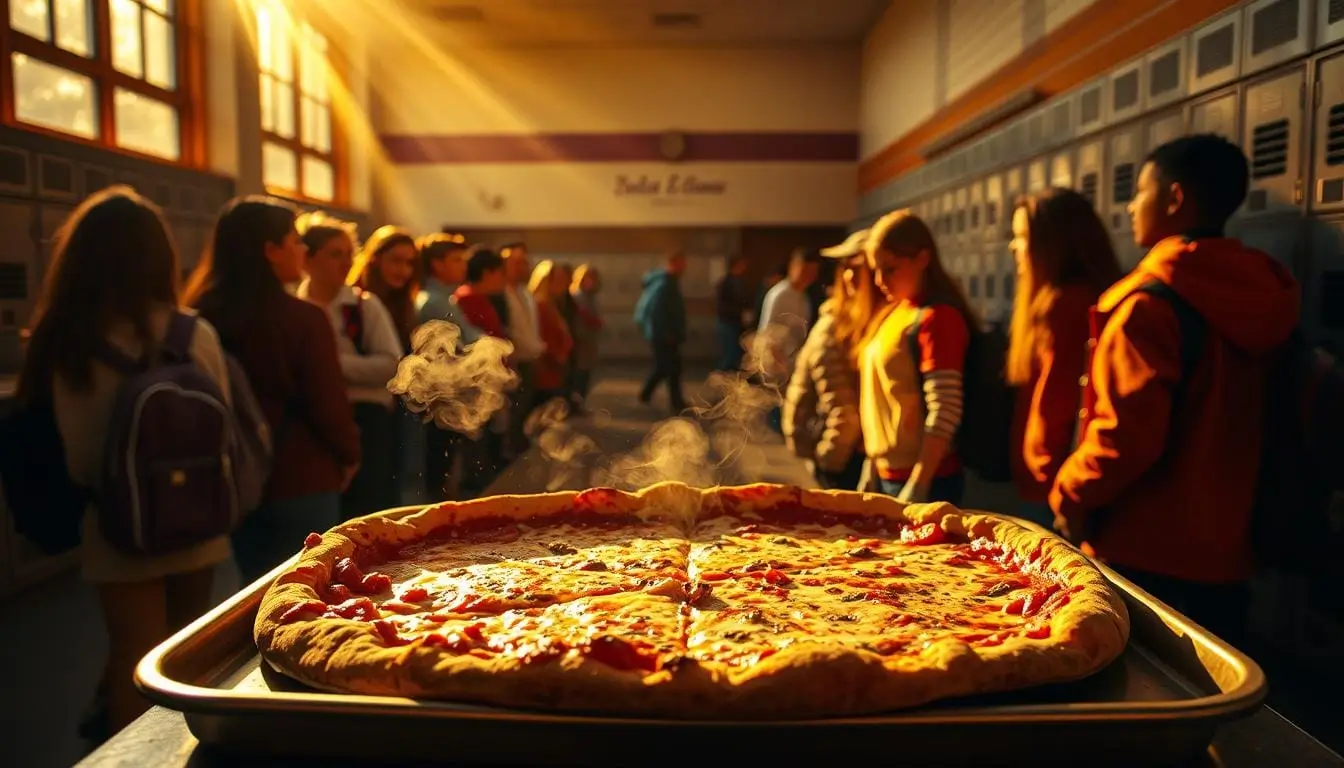Do you remember the excitement when pizza trays came out in the lunchroom? It was like a celebration in the cafeteria. For many, school pizza was the best part of the day. It had crispy edges, melted cheese, and the hope that your slice would be perfect.
Lunchroom pizza was more than just food. It was a tradition. It brought joy, even on tough days or during awkward times in school.
Think back to the 80s and 90s. School meals changed, but pizza stayed the same. Even with limited toppings, the basics like dough, sauce, and cheese were always there. Now, we see how lunchroom pizza connected us to our past.
Key Takeaways
- Lunchroom pizza remains a cultural touchstone, serving millions of students nationwide.
- Standard recipes use 2 pounds of dough and 3 cups of mozzarella per pizza, baked at 375°F for 25-27 minutes.
- Simple ingredients like cheese and sauce created lasting memories, even during decades when 80% of school meals leaned toward simpler, less-healthy options.
- Its rectangular slices and predictable portions offered comfort in the chaos of school days.
- Behind every pan—measuring 18×26 inches—lies a story of nurturing routines and shared meals.
The History of Lunchroom Pizza
Do you remember the first time you smelled pizza in school? School cafeteria pizza became a big part of American schools. It created many lunchtime memories. It was more than just a meal; it was a cultural touchstone.
Let’s look at how pizza became a regular part of the school lunch menu. It went from a rare treat to a weekly favorite.
Origins of Pizza in American Schools
In the 1970s, schools started trying new things on their lunch menus. By the 1980s, pizza was a hit because it was simple and everyone loved it. In 1988, the USDA made sure every slice was the same size.
Schwan’s provided the dough, and some schools even used real mozzarella. This showed that even school food could be good. “The pizza was a Friday tradition,” says one alum. It was the only day some kids got a vegetarian option.
Evolution of Lunchroom Offerings
“Food in US schools from when I was growing up in the 80s and 90s were, to put it mildly, not the healthiest,”
Early pizzas didn’t have as much cheese as we expect. But kids still loved them so much they would trade for extra slices. By the 1990s, school cafeteria pizza was everywhere, from kindergarten to high school.
Students loved it so much they would even barter for more. This shows how much they enjoyed it as a comfort food.
The Rise of Lunchroom Pizza
| Decade | Key Changes |
|---|---|
| 1980s | Standardized rectangular slices, pre-made dough |
| 1990s | Consistent recipes, Friday pizza days |
| 2000s | Growing nostalgia, health debates |
Mrs. Johnson’s big portions made pizza a special treat. Even though some thought the crust was too thick, it became a shared memory. Today, it’s a symbol of community and care in every slice.
What Makes Lunchroom Pizza Unique
There’s something special about school cafeteria pizza. It feels like stepping back in time. The first bite brings back memories of the lunchroom, the sound of trays scraping, and the chatter of friends.
This isn’t just any pizza. It’s a journey of taste and memory, wrapped in comfort and nostalgia.
“The crust was yeasty, thick, and spongy—like a warm cloud,” shared one alumnus, recalling their days at Wakelon School. “Even now, I crave that pillowy softness under the melted cheese.”
| Nutritional Insight | Serving Detail |
|---|---|
| Calories per slice | 263 |
| Cheese layer thickness | 1/4-inch melted mozzarella |
| Crust type | Hand-tossed, rectangular, and yeasted |
| Popularity rank | Top 1 of student lunch favorites nationwide |
The student lunch favorites status is more than taste. It’s about shared moments. Remember trading P.E. shirts for pizza passes? Or how the scent of baking dough meant it was Friday?
These memories make every slice a comfort, even as our tastes change. Today’s school cafeteria pizza still holds that magic. It combines simplicity with the warmth of connection.
Popular Lunchroom Pizza Varieties
As you walk through a school cafeteria, the smell of kid-friendly pizza welcomes you. Classics like cheese and pepperoni are always a hit. They offer comfort in every bite.
| Style | Crust Type | Signature Toppings |
|---|---|---|
| Classic Cheese & Pepperoni | Crispy rectangle | Stringy cheese, savory pepperoni |
| Veggie Deluxe | Crispy rectangle | Peppers, mushrooms, onions |
| BBQ Chicken | Crispy rectangle | Smoky BBQ sauce, shredded chicken |
The veggie deluxe is a favorite for those who love color and crunch. For a bold taste, try the BBQ chicken pizza. At Smart Mouth Pizza, we serve over 500 students every day. We believe pizza is more than food; it’s a way to connect.
Every week, we give 10% of our sales to feed those in need. We know that feeding kids is more than just lunch.
- Classic Cheese & Pepperoni: The original comfort food
- Veggie Deluxe: Fresh veggies meet melty cheese
- BBQ Chicken: Sweet-and-spicy twist on tradition
From the first bite to the last crumb, these pizzas remind us why they’re so beloved. Whether it’s a classic or a veggie-packed slice, each one has a story of care and flavor. These stories keep students coming back for more.
How Lunchroom Pizza is Made
Ever wonder how that tasty school pizza ends up on your tray? Let’s peek into the kitchen secrets! It all starts with a special dough recipe from the 1980s. This mix includes warm water, flour, and a bit of sugar.
We use 1 gallon of 110°F water mixed with 6¼ quarts of flour. This creates a silky batter poured onto greased pans. This method gives that soft, pillowy base you remember.

Next, we add the ingredients that make it shine. We use local tomatoes for sauce, fresh cheese, and toppings like veggies or pepperoni. Each 10×15-inch pan holds 12 slices.
We dust pans with cornmeal to keep crusts crisp—2 tablespoons scattered just right. Once assembled, pizzas bake at 475°F for 10-12 minutes until golden. That’s why every slice has that perfect balance: gooey cheese, bubbly edges, and a warm center.
- Crust magic: 2 tbsp olive oil mixed into dough
- Top it right: 2-3 cups shredded mozzarella melted to perfection
- Bake smart: 475°F ensures edges crisp while centers stay tender
Every step matters—from hand-rolling toppings to cooling racks that let flavors settle. This care turns ingredients into the lunchroom pizza that fuels school days. Now you know why that first bite feels like coming home.
Healthier Alternatives to Traditional Pizza
Who hasn’t wanted that cheesy, saucy pizza? But what if school lunches could be healthy and still taste great? Today, cafeteria lunch options focus on whole grains and colorful veggies. This turns old favorites into healthy choices for families.
Schools are now offering lighter crusts and toppings full of nutrients. This makes lunchtime better for everyone.
Whole Grain Crust Options
Whole grain crusts are full of fiber and keep you feeling full. Trader Joe’s Organic 3 Cheese Pizza is a tasty, affordable option. Look for crusts with whole wheat or ancient grains for extra nutrition.
Fresh Vegetable Toppings
Why not swap pepperoni for fresh veggies? Try:
- Roasted red peppers for natural sweetness
- Zucchini slices that caramelize in the oven
- Kale for a nutrient boost
For more ideas, check out Mediterranean-inspired veggie combos. Think arugula, tomatoes, and goat cheese!
Pizza as Part of a Balanced Meal
| Option | Calories | Sodium (mg) | Notes |
|---|---|---|---|
| Traditional Cheese Pizza (2 slices) | 600 | 1,800+ | Exceeds daily sodium limits |
| Whole Grain Veggie Pizza + Side Salad | 420 | 700 | Adds fiber and vitamins |
Pair your pizza with carrot sticks or fruit for a balanced meal. Small changes can make a big difference!
Tips for Enjoying Lunchroom Pizza

Let’s make every bite count! Turning lunchtime into a joyful experience starts with smart choices. Convenient lunch choices begin with the crust up—think of pizza as your canvas. At Smart Mouth Pizza, we know a little creativity goes a long way. Here’s how to elevate that kid-friendly pizza slice:
- Pair with nature’s goodness: Add apple slices, carrot sticks with hummus, or a small salad to round out meals. These convenient lunch choices add crunch and vitamins without extra prep.
- Hydrate with care: Opt for water with lemon or low-fat milk—like the creamy nostalgia of chocolate milk mentioned in our recipe. Try our easy pizza guide for family-friendly prep tips.
- Customize with care: Let kids sprinkle oregano or red pepper flakes on top. A toppings bar with pre-portioned veggies or cheeses lets them craft their perfect kid-friendly pizza—a fun way to explore flavors!
Remember, even a simple 5-minute rest after baking lets flavors settle, just like our 5-minute cool-down step in the recipe. With 500+ pizzas served daily in North Atlanta schools, we’ve seen firsthand how small tweaks create big smiles. Every slice shared also helps—our “10 pizzas = 1 meal donated” program means every bite gives back to the community.
Lunchroom Pizza Around the United States
Remember your first school pizza? It didn’t matter if it was in the Midwest or Northeast. That cheesy moment was special. School pizza is more than food; it’s a story tied to where you are.
Regional Toppings and Styles
Pizza in schools varies across the country. In New York, thin-crust slices are common. Chicago, on the other hand, offers deep-dish pizzas with thin crusts.
St. Louis has a crispy crust, while Colorado’s Mountain Pie is cheesy and layered. Some schools even try local toppings, like hot oil in Connecticut or taco-inspired pizzas in Iowa.
Notable School Districts for Pizza Lovers
- Zebulon, NC: Wakelon School’s pizza is famous, with its savory sauce and flaky crust.
- Columbus, OH: Ohio has many pizzerias, and schools serve Altoona-style pies with salami and bell peppers.
- Milwaukee, WI: Schools here use Wisconsin cheese, swapping mozzarella for processed cheese sauce.
Cultural Influences on Pizza Varieties
Visiting a school cafeteria is like tasting America’s diversity. In California, you might find queso fundido pizza. Texas schools have jalapeño-topped slices. The Midwest offers hearty meat-lovers pies.
These flavors connect cultures and generations. They’re not random; they’re meaningful.
“Our pizza days were the best part of the week. Now my kids love trying new styles too!” – Mrs. Thompson, parent and lifelong school food enthusiast
Every school pizza has a story. It’s a connection to place, heritage, and community. And that’s something every student can understand.
Hosting a Lunchroom Pizza Day
Imagine the joy of making lunchroom pizza in your own space. Planning a pizza day is easy. Start by picking kid-friendly pizza recipes that are comforting and simple. Our go-to batch serves eight, making it perfect for gatherings or classrooms.
Start by gathering your team. Everyone can help, from mixing dough to arranging toppings. This makes prep a fun adventure. For groups, double the recipe or get deals from local pizzerias.
Pro tip: Whole Foods’ pizza counter offers customizable options at $12 a pie. This is great for different tastes.
- Plan ahead: Make dough the night before for easy assembly.
- Assign roles: Little helpers can measure ingredients or set the table.
- Embrace imperfection: A slightly lopsided crust? That’s part of the fun!
Keep everyone’s energy up with fun activities. Set up a toppings bar with veggies, cheese, and herbs. Let everyone design their own pies. Add a pizza trivia game or a “build-your-own” art project using paper plates.
| Activity | Details |
|---|---|
| Topping Taste Test | Sample ingredients like sun-dried tomatoes or spinach to spark flavor exploration. |
| Pizza History Storytime | Share how pizza evolved from school lunchrooms to today’s favorites. |
| Decorate & Devour | Use edible markers to draw on crusts before baking. |
The magic is in the shared moments. Whether it’s for a classroom or a family reunion, these tips ensure every bite brings smiles. With a little prep and lots of heart, you’ll create memories that taste better than any store-bought slice.
Conclusion: Celebrating Lunchroom Pizza
The smell of melted cheese and warm crust feels like a hug from the past. Lunchroom pizza was more than a meal; it was the heart of school days. It brought joy and comfort to growing up.
Its legacy lives on in memories and recipes. The first bite of cafeteria-style pizza is still comforting. It reminds us of happy times.
The Role of Pizza in School Culture
When the lunch bell rang, everyone buzzed with excitement. The line was long, and friends talked about toppings. Lunchroom pizza was a cultural touchstone.
Even with healthier options today, its popularity remains. Matty Evans’ efforts to bring back Rise Up Pizza’s flavors show its lasting appeal. Food connects us, and pizza is a big part of that.
Lasting Memories and Flavorful Moments
That first crisp slice and sharing with friends are unforgettable. Whether making it at home or waiting for Evans’ food truck, it brings people together. It’s a bridge between generations.
Like finding a familiar taste in a cruise buffet, we recognize it everywhere. So, next time you make pizza, serve it with the same warmth as cafeteria days. The best traditions are shared and cherished.
We are interested in your feedback
There are no reviews yet. Be the first one to write one.

